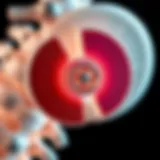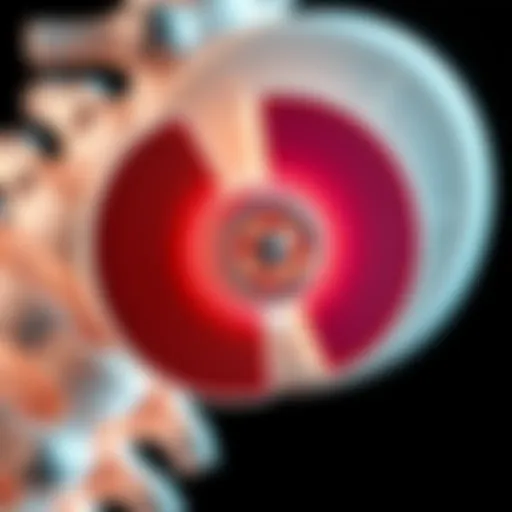Myasthenia Gravis: Latest Treatment Innovations in 2021


Intro
Myasthenia gravis, a complex neuromuscular disorder, has long posed various challenges in terms of treatment options and patient management. This autoimmune condition leads to weakness in voluntary muscles, manifesting symptoms that can severely impact a person's quality of life. The year 2021 saw significant breakthroughs in understanding how to better address this affliction. With fresh insights and advanced approaches slowly emerging from the shadows of past methodologies, it's crucial to dissect the innovations in treatment that have surfaced, the implications for patient care, as well as how personalized strategies might reshape the treatment landscape.
In dissecting the complexities surrounding myasthenia gravis, one must acknowledge the nuances in each patient’s experience. Factors such as age, comorbid conditions, and individual responses to previous treatments create a mosaic that complicates management approaches. Therefore, rising to meet these intricacies, contemporary treatments are increasingly geared towards customization, aiming not only to mitigate symptoms but also to promote overall well-being.
This article embarks on a detailed exploration of cutting-edge treatments, recent clinical trials, and the expanding therapeutic options designed specifically to combat myasthenia gravis. Readers can expect a synthesis of new findings, addressing the scientific evolution of treatment options, their efficacy, safety, and the role of tailored patient care in this ongoing narrative.
Prologue to Myasthenia Gravis
Understanding myasthenia gravis is crucial not only for medical professionals but also for researchers and educators alike. This autoimmune disorder poses unique challenges, influencing a myriad of daily activities for those affected. As we navigate through the complexities of this illness, it becomes evident that advancements in treatment are paramount. This article seeks to shed light on the evolving landscape of therapies available in 2021 and how they can significantly improve patient outcomes, highlighting the importance of keeping abreast of the latest research and innovations.
Understanding the Disorder
Myasthenia gravis, often abbreviated as MG, is characterized primarily by a weakness in the skeletal muscles, which can lead to varying degrees of disability. This disorder occurs when the immune system mistakenly attacks the communication between nerves and muscles, specifically targeting the acetylcholine receptors at the neuromuscular junction. The result? Muscles that tire easily and engage sluggishly, impacting everyday tasks like climbing stairs or even chewing food. Understanding its mechanics helps clinicians tailor treatment plans effectively, paving the way for better management strategies.
Prevalence and Demographics
The demographics of myasthenia gravis reveal a diverse picture that crosses age and gender boundaries. Typically, it emerges between the ages of 20 and 40, but it can just as often occur in older adults, usually after age 60. Notably, women are more likely to develop MG in their younger years, whereas men tend to face the brunt of the disorder in their later years. Overall, prevalence varies globally, but estimates suggest that around 14 to 20 individuals per 100,000 people are affected, underscoring the need for ongoing research and public awareness.
Classic Symptoms
The symptoms of myasthenia gravis can be a blend of frustration and confusion. Just picture a lit switch flickering in and out—this is similar to what those with MG experience daily. The hallmark symptoms include:
- Muscle weakness: Often noticeable in the eyes, leading to droopy eyelids or double vision.
- Difficulty swallowing: This may evolve to challenges with chewing food or gargling when speaking.
- Fatigue: As muscles tire easily, daily activities can become exhausting.
These symptoms typically worsen with activity and improve with rest—an unpredictable pattern that can confound both patients and clinicians alike. The emotional toll can also be significant, creating an urgent need for supportive therapies and new treatment paradigms.
"Understanding symptoms is the first step in navigating the complexities of myasthenia gravis."
Through a thorough comprehension of these facets—disorder mechanics, demographics, and symptoms—the journey toward innovating treatment approaches becomes more coherent and aligned with the patients’ actual needs.
Current Treatment Modalities
Understanding the current treatment modalities for myasthenia gravis is crucial for healthcare professionals and researchers, as this knowledge directly impacts patient care and outcomes. Emphasizing both pharmacological and non-pharmacological strategies is essential in the management of this complex disorder. The treatment landscape has evolved significantly, introducing innovative therapies that target the underlying mechanisms of myasthenia gravis while enhancing patients’ quality of life. By exploring established therapies, immunosuppressants, and cholinesterase inhibitors, this section aims to provide a comprehensive view of the available treatment options.
Established Therapies
Established therapies for myasthenia gravis have long set the foundation for treatment. In most cases, physicians begin with medication aimed at symptom management. One common approach is the use of corticosteroids. These powerful anti-inflammatory drugs help control the immune response that attacks the acetylcholine receptors at the neuromuscular junction, thus easing muscle weakness. Another established therapy includes plasma exchange (plasmapheresis), where blood is filtered to remove harmful antibodies, providing temporary relief for patients during exacerbations.
Moreover, intravenous immunoglobulin (IVIg) therapy is another option that has gained traction. This treatment infuses antibodies from healthy donors, which can modify the immune response and decrease disease activity. It’s worth noting that these therapies come with a set of potential side effects and require careful monitoring by health professionals to optimize their effectiveness.
Role of Immunosuppressants
Immunosuppressants play a critical role in managing myasthenia gravis, particularly for individuals who do not respond adequately to traditional therapies. These medications work by dampening the immune response, thereby preventing the immune system from attacking the body’s own tissues, specifically the neuromuscular junction. Among the most frequently used immunosuppressants are azathioprine and mycophenolate mofetil, which have been shown to help reduce symptoms and improve overall functional status over time.
In selecting an immunosuppressant, physicians must consider factors like patient history, potential drug interactions, and individual tolerance. The efficacy of these medications can vary significantly from person to person, so careful evaluation of the patient’s response is key. Overall, immunosuppressants represent a cornerstone in the management of myasthenia gravis, especially in severe cases.
Cholinesterase Inhibitors
Cholinesterase inhibitors, such as pyridostigmine, are frequently employed as first-line treatments in myasthenia gravis. These drugs work by blocking the enzyme that breaks down acetylcholine at the neuromuscular junction, thus enhancing communication between nerves and muscles. Increased acetylcholine availability can lead to better muscle contraction and improved strength, which is invaluable for many patients.


One benefit of cholinesterase inhibitors is their relatively low toxicity compared to other treatment options. However, they may not suffice alone for all patients; some individuals may experience limited response, requiring additional therapies. Health professionals often face the challenge of adjusting dosages to strike a balance between efficacy and side effects, such as gastrointestinal disturbances and muscle cramps.
In summary, the landscape of current treatment modalities for myasthenia gravis encompasses established therapies, the critical role of immunosuppressants, and the use of cholinesterase inhibitors. Understanding these treatment avenues is vital for anyone engaged in the fight against this challenging neuromuscular condition.
Emerging Treatments in
The rapid evolution of treatment modalities for myasthenia gravis (MG) in 2021 marks a crucial point in improving patient outcomes. As understanding of the disorder matures, new strategies emerge that offer hope and potential efficacy for individuals diagnosed with MG. The spotlight is on innovative therapies that not only address symptoms but also tackle the underlying mechanisms of the disease. This brings forth a tantalizing prospect for more effective management and personalized approaches tailored to unique patient profiles.
Novel Antibody Therapies
Recent advancements in novel antibody therapies have revolutionized the way we look at treatment for myasthenia gravis. These therapies target specific pathways in the immune system, potentially altering the course of the disease. One standout example includes eculizumab, which inhibits the complement cascade—a part of the immune response that has been implicated in MG.
The mechanism here is quite interesting. By stopping the activation of the complement system, eculizumab provides symptomatic relief and reduces the incidence of crisis situations in patients. The results, while still subject to ongoing scrutiny, have shown that nearly 60% of patients experienced significant improvement in muscle strength and reduced fatigue levels.
"Emerging antibody therapies are reshaping the treatment realm of myasthenia gravis, shedding light on pathways we barely understood before."
- Understanding the potential for these therapies means acknowledging certain considerations:
- Cost-Effectiveness: Many of these drug regimens can be expensive, leading to accessibility concerns for some patients.
- Immunological Implications: With the modulation of immune response, there comes a risk of increased susceptibility to infections.
Role of Complement Inhibition
Complement inhibition is another emerging frontier for treating myasthenia gravis. Beyond eculizumab, newer agents like ravulizumab offer similar benefits but with potentially longer dosing intervals and improved patient adherence. This aspect of treatment is instrumental as patients often experience fatigue, making frequent hospital visits burdensome.
Complement proteins play a significant role in the pathological process of myasthenia gravis. By mitigating their function, these agents not only aim to enhance muscle transmission but also aim to stabilize the immune upheaval that characterizes MG. Clinicians and researchers alike are excited about the prospect of employing complement inhibitors as first-line therapies, due to their targeted approach.
Some key takeaways when considering complement inhibition include:
- Patient Monitoring: Regular follow-ups to monitor efficacy and safety profiles are essential as the treatment landscape evolves.
- Hybrid Therapies: These medications could potentially be combined with traditional therapies to enhance overall effectiveness.
Investigational Agents Under Study
Investigational therapies represent the frontier in treating myasthenia gravis as research continues to push the envelope. Many clinical trials are underway to assess compounds that could enhance treatment outcomes, with a focus on not just efficacy but also safety and tolerability.
One promising class of drugs includes small molecules that target cellular pathways directly linked to neuromuscular transmission, providing an alternative for patients who may not respond adequately to current therapies. These investigational agents are being evaluated in various phases of clinical trials, aiming to establish their therapeutic roles.
Important considerations for investigational agents encompass:
- Patient Selection: Identifying suitable candidates for these trials is critical, ensuring the risks are outweighed by potential benefits.
- Long-term Effects: As with any new treatment, understanding the long-term implications on health and wellbeing is paramount.
- Communication: Maintaining open lines of communication with patients about what they can expect is vital for managing expectations and adherence.
In summary, the emerging treatments for myasthenia gravis in 2021 signify a remarkable shift in the approach to managing this complex disorder. Through targeted therapies like antibody treatments and complement inhibitors, combined with ongoing research, it's a monumental time for advancing patient care and developing personalized treatment landscapes.
Clinical Trials and Research Insights
Understanding the role of clinical trials in the management of myasthenia gravis is paramount. These trials serve as the cornerstone for establishing the efficacy of new treatment modalities and provide insight into the best practices for patient care. They help in determining how effective newer therapies are when compared to the established ones. Moreover, research findings from these trials can inform clinical decisions, shaping treatment protocols and optimizing patient outcomes.
Recent Trial Findings
Recent clinical trials have brought to light several promising findings in the treatment of myasthenia gravis. For instance, studies focusing on complement inhibition therapies, like eculizumab, have shown substantial improvements in patients' symptoms and quality of life. Not only do these findings push the envelope for what's possible in treatment, but they also highlight the dynamic nature of ongoing research in this arena. Trials have recorded varied responses among participants, suggesting that individual genetics and baseline characteristics play a crucial role in the treatment's success.
Additionally, other trials targeting novel antibody therapies are demonstrating potential benefits. In one such study, a subgroup of treated patients reported a notable reduction in muscle fatigue and improved strength after just a few weeks of receiving treatment.


Long-term Outcomes and Efficacy
Evaluating the long-term outcomes of these innovative treatments is essential. Many trials are extending beyond the initial treatment phase to observe how well patients fare over time. The data suggests that patients who responded positively at the onset of treatment continued to maintain enhancements in function and reduced symptom severity over months and even years.
The metrics for success are often varied. Commonly assessed factors include improvements in muscle strength, reductions in symptoms like ptosis, or even the ability to resume daily activities that the disease initially compromised. It’s important to be mindful, however, that not all patients will have the same response, leading back to the discussion on personalized treatment approaches, which can be more effective than one-size-fits-all therapies.
Safety Profiles of New Treatments
Safety remains a critical concern, especially when introducing new treatments to the myasthenia gravis arsenal. Fortunately, recent trials are increasingly focusing on safety profiles alongside efficacy. Outcomes from these studies stress the importance of monitoring for potential side effects, as some innovative therapies can have serious implications for patients.
For example, while eculizumab showed marked benefits, some patients experienced adverse effects, including infections or infusion-related reactions. Thus, understanding the safety profiles of these treatments is pivotal before they can be widely accepted into clinical practice.
It is imperative for healthcare professionals to weigh the benefits of emerging treatments against potential risks, ensuring they provide comprehensive care that prioritizes patient safety.
Personalized Treatment Approaches
Personalized treatment approaches in the management of myasthenia gravis (MG) highlight the shift from one-size-fits-all therapies to tailored methodologies that consider the unique characteristics of each patient. This signifies a major leap in understanding that the variation in genetic makeup, disease manifestation, and individual responses to therapies play a critical role in treatment outcomes. With the complexity of MG, utilizing personalized strategies not only maximizes the efficacy of interventions but also minimizes potential side effects, creating a safer and more effective management path for patients.
Genetic Considerations
In myasthenia gravis, genetic factors contribute significantly to susceptibility and response to treatments. Variations in genes, particularly those involved in the immune response and neuromuscular transmission, influence how a patient develops MG and how they respond to therapies.
For instance, patients with specific genetic markers may respond better to certain immunosuppressants or monoclonal antibodies. Research into these genetic variants is still in its infancy but holds promise for identifying patient subsets who could benefit from targeted therapies. Knowing the genetic landscape might enable clinicians to choose treatments that align more closely with the patient’s inherent biological profile. In turn, this can lead to enhanced therapeutic success and reduced adverse effects.
Biomarkers in Treatment Selection
Biomarkers are essential in the realm of personalized medicine, acting as indicators for treatment decisions. In myasthenia gravis, the presence of certain autoantibodies, such as acetylcholine receptor antibodies, serves as a key biomarker. They not only aid in diagnosis but also lend insight into treatment planning.
"Identifying specific biomarkers can guide clinicians in predicting disease severity and appropriate therapy, marking a significant stride toward personalized treatments."
Additionally, ongoing research aims to identify new biomarkers that could signal better responses to emerging treatments or even predict relapses. By harnessing these indicators, healthcare providers can implement intervention strategies more attuned to the patient’s conditions rather than relying on generalized protocols. This tailor-made approach enhances overall patient care and can lead to superior outcomes.
Multidisciplinary Management
A cornerstone of effective myasthenia gravis treatment is the application of multidisciplinary management. This approach encompasses a broad spectrum of healthcare professionals, including neurologists, rheumatologists, pharmacists, physiotherapists, and mental health experts. By engaging a diverse range of specialists, personalized treatment strategies can be crafted that encompass not just medical therapies but also supportive care.
Each provider brings a unique perspective that can influence treatment decisions:
- Neurologists may focus on pharmacological interventions to mitigate symptoms.
- Physical therapists can develop exercise regimens that enhance physical capabilities without exacerbating fatigue.
- Dieticians might tailor nutritional plans to support overall health and address any specific dietary needs in patients.
- Mental health professionals can provide counseling for emotional support, particularly important given the challenges of living with a chronic illness.
By collaborating closely, these professionals ensure that every facet of a patient's life is addressed, creating a holistic care environment that can significantly improve patient satisfaction and wellness. This collaborative model sets the stage for optimized, personalized care that recognizes the individuality of each patient's journey through MG.
Complementary and Supportive Therapies
The journey of managing myasthenia gravis often goes beyond traditional medical treatment. Complementary and supportive therapies play a crucial role in enhancing the overall well-being of patients. These therapies are designed to support the body’s innate ability to heal, address various facets of the disorder, and improve the quality of life. They can serve as valuable additions to conventional treatment approaches, helping patients navigate their condition in a more holistic manner.
Rehabilitation Strategies
Rehabilitation is about more than just physical recovery; it involves a layered approach targeting mobility, strength, and endurance. In the context of myasthenia gravis, tailored rehabilitation strategies can lead to significant improvements in daily functioning.
- Physical Therapy: Specialized exercises aimed at improving muscle strength and functionality are essential. These movements ensure that patients maintain as much mobility as possible while managing fatigue, which is a core challenge.
- Occupational Therapy: Adapting daily tasks can offer a new lease on overall functionality. Occupational therapists work to identify areas of difficulty for patients and help modify tasks or at-home environments to enhance independence. This could be anything from the way groceries are carried to how one navigates stairs.
- Speech Therapy: Speaking and swallowing challenges are common due to muscle weakness. Speech therapists implement exercises specifically targeted at nourishing these skills, allowing for clearer communication and improved safety during eating.


"Rehabilitation isn't just about getting better; it’s about learning how to live well with your condition."
Nutritional Support
A well-rounded diet is pivotal for patients with myasthenia gravis. Nutrition serves not only as a means to sustain energy but also influences overall muscle function and immune health.
- Balanced Diet: Emphasizing whole foods rich in vitamins and minerals can bolster the immune system and reduce inflammation. Foods high in antioxidants – like fruits and vegetables – can be particularly beneficial.
- Hydration: Staying hydrated is often overlooked, yet it’s vital for muscle activity and energy levels. Dehydration can lead to fatigue, making it crucial for patients to drink plenty of fluids throughout the day.
- Meal Strategies: For patients facing swallowing difficulties, smaller, frequent nutrient-rich meals might provide an easier route to adequate intake compared to larger meals. Blending or softening foods can also enhance safety and comfort during dining.
Psychosocial Considerations
Living with myasthenia gravis can be emotionally taxing. As such, psychosocial considerations are essential to a comprehensive approach.
- Support Groups: Connecting with others who experience similar challenges provides a sense of community and understanding. Support groups can be a platform for sharing strategies and offering emotional support, warding off feelings of isolation.
- Counseling: Engaging with a mental health professional can help address anxiety, depression, or stress management. Coping strategies and therapy can empower patients and foster resilience against the emotional waves that may accompany chronic illness.
- Mindfulness and Stress Reduction: Techniques such as meditation or yoga can not only improve mental health but also support physical well-being. Reducing stress can alleviate muscle tension and overall fatigue, thus enhancing quality of life.
Each of these elements under Complementary and Supportive Therapies works synergistically to create a more holistic treatment approach for myasthenia gravis. The combined focus on physical, dietary, and mental health paves the way for patients to navigate their condition with greater resilience and improved well-being.
Future Directions in Research
Research into myasthenia gravis (MG) is entering a new phase of ingenuity and exploration. This evolving landscape not only broadens our understanding of the disorder but also paves the way for better treatment strategies. The focus on future directions is crucial for several reasons; it highlights the necessity for innovation in management approaches and underscores the importance of understanding the underlying mechanisms of the disease. As we look toward potential advancements, the guiding objective remains the improvement of patient care and outcomes.
Areas of Need in Myasthenia Gravis Research
There are multiple areas where research into myasthenia gravis shows significant promise yet remains under-explored. A primary area of need is the investigation of environmental factors contributing to the onset and exacerbation of the disorder. Understanding how these factors interact with genetic predispositions may enable healthcare providers to develop more effective prevention and management strategies.
Additionally, there is a pressing demand for more granular research into the heterogeneity of MG symptoms. Each patient may present with a unique set of challenges that impact their quality of life. By focusing on personalized treatment trajectories, the medical community can begin to tailor therapies that cater better to individual patient profiles. To summarize, areas of need include:
- Investigating environmental triggers that worsen symptoms.
- Understanding the genetic components that may predispose individuals to MG.
- Personalized research efforts to tailor treatments to individual patient experiences.
Advances in Gene Therapy
Gene therapy represents a potentially revolutionary pathway for treating myasthenia gravis. Current research is delving into gene editing techniques, such as CRISPR-Cas9, which could help modify the genes responsible for producing the faulty proteins that disrupt neuromuscular transmission. By targeting the underlying genetic causes, this approach could provide a long-lasting solution rather than merely symptomatic relief.
Efforts are also underway to explore the delivery of therapeutic genes directly into muscle cells, ideally leading to enhanced efficacy and reduced side effects. Furthermore, studies suggest that gene therapy could minimize the reliance on long-term immunosuppressants, which often come with their own set of challenges, such as increased susceptibility to infections. Overall, the advances in gene therapy could mark a transformative shift in how MG is treated and managed.
Potential Breakthroughs on the Horizon
Looking ahead, several breakthroughs in the field of myasthenia gravis appear to be on the cusp of realization. One of the most exciting developments is the exploration of bi specific antibodies—a type of therapeutic agent that can simultaneously target two different antigens. This means that treatments could be more effective, addressing the complexities of MG in a holistic manner.
Moreover, researchers are investigating the impact of microbiome modulation on immune response, highlighting the link between gut health and neuromuscular conditions. This line of thought underscores a broader, more integrated approach to treating MG by considering lifestyle factors, dietary adjustments, and probiotics as complementary to traditional treatments.
As research progresses, the hope is that these frontier technologies will converge to create a comprehensive treatment matrix, potentially changing the landscape of care for individuals battling myasthenia gravis.
Closure
The conclusion of this article holds significant weight in synthesizing the vast knowledge presented about myasthenia gravis and the various innovative treatment approaches discussed throughout the sections. As we navigate through complex nuances of this neuromuscular disorder, it becomes clear how essential it is to stay informed about advancements in research and treatment strategies.
One crucial aspect touched upon is the importance of personalized treatment plans. Since myasthenia gravis manifests differently in each individual, tailored therapies that consider genetic variations and specific biomarker profiles can lead to improved patient outcomes. This individualized approach ensures that patients receive care that aligns closely with their unique physiological responses, potentially enhancing the efficacy of interventions.
Moreover, the article emphasizes the need for a multidisciplinary management strategy. Involving different healthcare professionals in the treatment process not only broadens the scope of care but enriches the patient's experience. For example, collaborating with physiotherapists can complement pharmacological treatment by enhancing physical function and quality of life.
"Personalization and comprehensive care are the cornerstones of effective management in myasthenia gravis, reflecting the diverse needs of each patient."
Furthermore, understanding the safety profiles of emerging therapies and their implications on long-term patient health cannot be underestimated. As novel treatments hit the market, continuous evaluation of their safety and effectiveness becomes crucial in maintaining patient trust and ensuring optimal therapeutic strategies are adopted.
In essence, the conclusion neatly ties together the threads of discussion about innovative treatments, highlighting a future where patients are empowered through informed choices and ongoing research. The progress made in 2021 not only shines a light on current possibilities but also raises hopes for breakthroughs on the horizon, aiming for enhanced quality of life for those affected by this enduring condition.
Through collaboration, research, and a commitment to understanding and addressing the multifaceted nature of myasthenia gravis, we can foster a more hopeful landscape for patients and caregivers alike.







